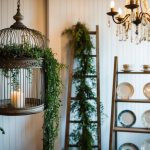Maximizing Natural Light: Clever Home Decor Strategies for a Brighter Space
Blinds, Shades, and Translucent Options
Blinds and shades offer another practical solution for managing natural light. Blinds, available in materials like wood, metal, and plastic, offer adjustable slats that can be tilted to control the amount of light and privacy. They are durable and functional, making them suitable for kitchens and bathrooms where moisture resistance is necessary.
Shades come in various styles, such as roller, Roman, and cellular. Roller shades are simple and sleek, providing a modern touch. Roman shades add a decorative element with their fabric folds, while cellular shades offer excellent insulation with their honeycomb structure. Translucent shades balance light filtering and privacy, diffusing sunlight softly throughout a space.
Translucent shades are particularly useful in spaces like home offices and reading nooks, where even, glare-free light is beneficial. These options offer a blend of form and function, complementing various interior styles while enhancing a room’s brightness.
Introducing Skylights and Solar Tubes
Adding natural light through innovative methods like skylights and solar tubes can enhance the brightness and ambiance of any home. Both options offer unique benefits and considerations based on their design and placement.
Skylight Design and Placement
Skylights can transform a dark room into a bright, inviting space. The design of a skylight is crucial, with choices ranging from fixed to vented models. Fixed skylights primarily provide light, while vented options also offer ventilation. The location should ensure maximum sunlight exposure, often installed in areas directly under the roof.
The size and shape of the skylight impact light distribution. Smaller models fit more targeted applications, while larger skylights illuminate expansive areas. Angling the skylight properly prevents excessive heat gain and glare. Insulated glazing and UV protection features help manage indoor temperature and safeguard furnishings from sun damage.
Advantages of Solar Tubes and Light Tubes
Solar tubes, also known as light tubes or sun tunnels, are an efficient way to channel sunlight into interior spaces. These tubes consist of a dome that captures sunlight on the roof and a highly reflective tube that directs the light inside. Solar tubes are particularly effective in smaller, enclosed spaces like hallways, closets, or bathrooms.
Installation is relatively straightforward, often requiring less structural modification than traditional skylights. Solar tubes provide excellent light with minimal heat transfer, making them energy-efficient. They can also be fitted with diffusers to spread light evenly. The compact design allows for installation in areas that may not support larger skylights. This adds versatility in bringing natural light into nearly any part of the home.
Incorporating Nature and Landscaping
Using plants and strategic landscaping not only enhances a home’s visual appeal but also helps in optimizing natural light inside and outside the house.
Indoor Plants for Light Filtration
Incorporating indoor plants such as ferns, succulents, and palm varieties can enhance natural lighting. These plants filter light while adding a vibrant touch to living spaces. Placing them near windows allows them to soften the incoming sunlight, reducing glare and creating a more pleasant atmosphere. Taller plants can be used to direct light deeper into rooms, improving overall illumination.
Selecting plants with lighter, reflective leaves is ideal. They help in maximizing light distribution. Varieties like Spider Plants and Monstera are excellent choices. Always consider the plant’s care requirements to ensure they thrive while serving their function in optimizing light.
Exterior Landscaping Considerations
Thoughtful exterior landscaping influences how much natural light enters the home. Strategically positioned trees and shrubs can provide shade, reducing the harshness of direct sunlight. Deciduous trees are particularly useful for creating seasonal balance. They block sun in summer and allow more light in winter when they shed their leaves.
Hardscaping elements like light-colored pavements and reflective surfaces can also brighten adjacent interior spaces. Gardens with low-lying plants nearer to windows and taller plants positioned farther away can maintain open sightlines, contributing to a brighter indoor environment. Enhancing pathways and other exterior elements in light shades can also improve daylight reflection into the home.



